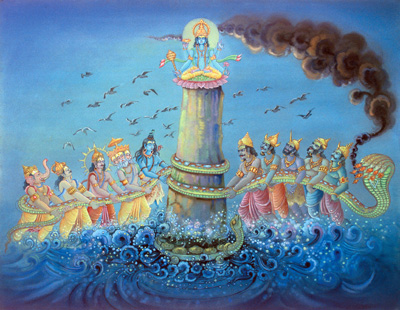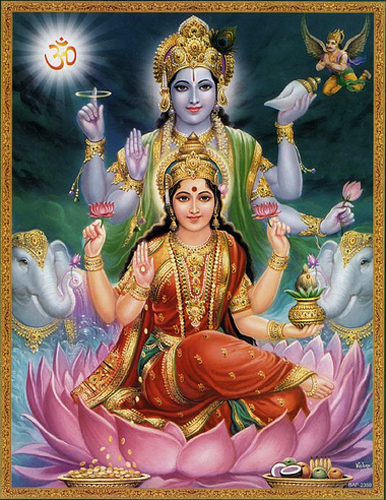Author: Meredith S. Broyles
Goddess Lakshmi
Lakshmi
Lakshmi, the goddess of prosperity and fortune, (Dimmit) among many other virtues, is the loyal wife of Vishnu. The earliest Vedic literature calls her Sri, and she later developed under the name Lakshmi (Kinsley 18). Her name developed from early Sanskrit and means “goal,” and it “represents the goal of life which includes worldly and spiritual prosperity” (Pandit). Lakshmi, or Sri, is credited as being the “mother of the world” (Dimmit). While Lakshmi is prominent throughout countless facets Hinduism, for this project, I will focus on three key aspects of Lakshmi: her relation to Vishnu, stories of Lakshmi, and her associated symbols.
Lakshmi in relation to Vishnu
Vishnu “represents the force of preservation in the universe,” and he is the “most important object of devotion in India” (Molloy 97). It is common for each male deity have an associated female counterpart. “They are so much a part of the male god, that the god cannot be active without them, and thus are called “shaktis” (“energies”) because they allow the male gods to be effective in the human world” (Molloy 102). Lakshmi is the shakti of Vishnu, and as his consort, she “dispenses good luck and protection” (Molloy 103). The two deities are each other’s counterparts in numerous ways. For example, Vishnu is meaning and Lakshmi is speech, Vishnu is knowledge and Lakshmi is insight, Vishnu is behavior and Lakshmi is conduct (Dimmit) and so on. These are just a few examples of the many ways that Lakshmi and Vishnu compliment each other. Overall, Vishnu “is all that is known as male, and Sri all that is known as female. There is nothing more beyond these two!” (Dimmit).
Vishnu and Lakshmi sometimes appear as a single divinity. Prior to around A.D. 400 when Lakshmi is almost exclusively associated to Vishnu, Sri is also connected to may other male deities (Kinsley 26). Numerous tales exist of her relation to these Gods, but it is said that Sri is attracted to the many forms that Vishnu takes on, and so she ultimately devotes herself to him in matrimony. Because Vishnu and Lakshmi are so interconnected, she often serves as his subdued counterpart when dealing with his devout followers. “While Vishnu is often conceived of as a stern, easily-perturbed patriarch, Lakshmi represents a more soothing, warm and approachable mother figure who willingly intervenes in the lives of devotees on his behalf” (New World Encyclopedia). She serves as the advocate for mortals on his behalf and as is his rational partner.
The rebirth of Lakshmi and the festival of Diwali
The first story necessary to know in order to study Lakshmi is the churning of the ocean of milk. This is when Lakshmi was reborn. I will provide a very abbreviated version of the story to highlight its relation to Lakshmi, but for the full story, reference the citations at the end of this page. One day, Lakshmi became annoyed with Indra’s arrogance, and so she left into the ocean (BBC). The world became a dark, and without her, there was no good fortune or prosperity. In the story, the gods want to retrieve Lakshmi and the amrita (the nectar of immortality) from the depths of the cosmic ocean (Encyclopedia Britannica). After the Indra consulted Vishnu, who was in his tortoise form of Kurma, they began to work together to fight the demons to obtain the amrita from the sea. The gods and the demons stirred the ocean of milk with a naga (half man, half serpent) by wrapping it around Mount Mandara. Th e gods pulled from one side and the demons pulled from another. Eventually, after 1000 years, the churning amounted to many treasures. Several deities, including Lakshmi on her lotus flower, emerged from the whirlpool along with many other treasures often associated with Vishnu, and this marks the rebirth of Lakshmi (Encyclopedia Britannica). After retrieving the treasures and Lakshmi, the Gods chased the demons from the world (BBC).
e gods pulled from one side and the demons pulled from another. Eventually, after 1000 years, the churning amounted to many treasures. Several deities, including Lakshmi on her lotus flower, emerged from the whirlpool along with many other treasures often associated with Vishnu, and this marks the rebirth of Lakshmi (Encyclopedia Britannica). After retrieving the treasures and Lakshmi, the Gods chased the demons from the world (BBC).
Diwali, which was celebrated on November 11th this year, is known as the “Festival of Lights.” On the third day of Diwali festival, the night of Amavasya, is the most important for the celebration of Lakshmi. On this day, “strains of joyous sounds of bells and drums float from the temples as man is invoking Goddess Laxmi in a wondrous holy “pouring-in” of her heart” (Lakshmi Puja on Diwali). Diwali is celebrated by Hindu’s all over the world, and is often recognized for its colorful displays, a multitude of lights, and hymns honoring Lakshmi on her day. It is said that on this joyous day, Sri “showers her blessings on man for plenty and prosperity ” (Lakshmi Puja on Diwali). A puja is a ceremony that is carried out at in order to worship a deity, and specifically on this day during Diwali, Lakshmi is honored with a Puja. While Diwali is also concentrated around other stories, in North and West India, Lakshmi is a central figure for worship. In tandem with the theme of the festival of lights, many Hindu’s light the lamps in their home to serve as a light to guide Sri’s path. People also extensively clean their houses for Lakshmi because it is said she will visit the cleanest houses first (Lakshmi Puja on Diwali).
” (Lakshmi Puja on Diwali). A puja is a ceremony that is carried out at in order to worship a deity, and specifically on this day during Diwali, Lakshmi is honored with a Puja. While Diwali is also concentrated around other stories, in North and West India, Lakshmi is a central figure for worship. In tandem with the theme of the festival of lights, many Hindu’s light the lamps in their home to serve as a light to guide Sri’s path. People also extensively clean their houses for Lakshmi because it is said she will visit the cleanest houses first (Lakshmi Puja on Diwali).
Lakshmi and her associated symbols
As noted earlier, Lakshmi is a very maternal figure in Hinduism. In later Hinduism history, her fertility is connected to rich agricultural production. Her son is named Kardama, meaning mud, which pairs with her description as being like fertile soil in a harvest (Kinsley 20 ). Early villagers, particularly women, worshipped Lakshmi in the form of cow dung in certain instances, because of her relation to abundant harvests (Kinsley 19).
). Early villagers, particularly women, worshipped Lakshmi in the form of cow dung in certain instances, because of her relation to abundant harvests (Kinsley 19).
In almost all of the pictures of Sri, she is sitting on top of a lotus flower. Lakshmi is often related to fertility, and the lotus is a symbol that is most commonly used to represent that. The lotus flower symbolizes fertility and life in how it is rooted into primordial waters (Kinsley 21). It is representative of the entire created world (Kinsley 21). The lotus grows from the naval of Vishnu, which represents the beginning of cosmic creation, and Lakshmi “is the nectar (the rasa) of creation which lends to creation its distinctive flavor and beauty” (Kinsley 21). Also in pictures of Lakshmi, she is almost always seen wearing a red dress and possesses gold coins, “which denotes prosperity” (Pundit).
The lotus also has a second symbolic meaning. The flower is rooted in mud, but blossoms above the water, and this image symbolizes the purity and spiritual power of Lakshmi (Kinsley 21). Just as Lakshmi sits atop the lotus, other gods and goddesses in Hinduism do that same to mark their spiritual authority (Kinsley 21). The mud from which the lotus grows is representative of the material world, and it is said that figures, such as Sri, who sit above the mud on the lotus exist in a “state of refinement that transcends the material world” (Kinsley 21).
In addition to the lotus flower, Lakshmi is commonly associated with elephants. Elephants, quite often seen in images of Lakshmi, also have many associated meanings. Ancient Hinduism tradition says that elephants once had wings and flew amongst the clouds and showered the earth with rain from their trunks (Kinsley 22). These so called “sky elephants” were, “cursed by a sage when they landed on a tree under which he was meditating and broke his concentration” (Kinsley 22). From this story, elephants thus lost their wings and remained on earth, but are still known for providing water from their trunks. This abundance of water goes in tandem with the symbol of Lakshmi’s fertility, and thus they are often depicted as showering her with their trunks in pictures (Kinsley 22). Another meaning of the elephants relate to their royal authority. Because many kings in ancient India kept many elephants, they were used for military campaigns as well as for ceremonial processions (Kinsley 22). Because of their strong connection to royalty, Sri also became associated with royal authority. In keeping with Hinduism in total, the symbolism of the elephants is widespread and varied. Other accounts that say the elephants represent the prestige associated with wealth. The elephants exist to serve as a reminder “to not earn wealth merely to acquire name and fame or only to satisfy his own material desires, but should share it with others in order to bring happiness to others in addition to himself” (Pundit). Additionally, some say that the elephants represent the four ends of human life as well. Regardless, elephants are almost always associated with and are present in pictures of Lakshmi.
Another common aspects of her physical appearance that is often present in pictures of Lakshmi are her multiple arms. “The four arms represent the four directions in space and thus symbolize omnipresence and omnipotence of the goddess” (Pandit). In addition, the four hand “represent the four ends of human life: dharma (righteousness) karma (genuine desires), artha (wealth) and moksha (liberation from birth and death)” (Pandit). These stages of life are a central theme in Hinduism and guide the lives of many Hindu’s
Overall, Lakshmi is a deity worth knowing in Hinduism. She is the primary symbol of wealth and prosperity, and her association with the Supreme Being Vishnu is highly relevant to her image as the “mother of the world.”
Works Cited
“Churning of the Ocean of Milk | Hindu Mythology.” Encyclopedia Britannica Online. Encyclopedia Britannica, 19 Feb. 2015. Web. 24 Nov. 2015.
Dimmitt, Cornelia. Classical Hindu Mythology: A Reader in the Sanskrit Purāṇas. Philadelphia: Temple UP, 1978. Print.
Kinsley, David R. Hindu Goddesses Visions of the Divine Feminine in the Hindu Religious Tradition. Berkeley: U of California, 1988. Print.
“Lakshmi.” BBC News. BBC, 24 Sept. 2009. Web. 24 Nov. 2015.
“Lakshmi Puja on Diwali.” Lakshmi Puja,,Lakshmi Pujan,Laxmi Diwali Pujan,Laxmi Puja 2015. Society for the Confluence of Festivals in India (SCFI). Web. 24 Nov. 2015.
Molloy, Michael. Experiencing the World’s Religions: Tradition, Challenge, and Change. 4th ed. Boston: McGraw Hill Higher Education, 2008. Print.
“New World Encyclopedia.” New World Encyclopedia, . 27 Jun 2009, 11:12 UTC. 24 Nov 2015, <http://www.newworldencyclopedia.org/p/index.php?title=New_World_Encyclopedia:Terms_of_Use&oldid=943147>.
Pandit, Bansi. “Hindu Deities: Goddess Lakshmi.” Hindu Deities: Goddess Lakshmi. Kashmir. Web. 24 Nov. 2015. http://www.koausa.org/Gods/God6.html
Photos
https://www.flickr.com/photos/arjuna/3505573638
http://www.sanatansociety.org/indian_epics_and_stories/the_churning_of_the_ocean.htm#.VlPkZWSrRPM
http://indigointernational.org/wp-content/uploads/2012/03/lakshmi.jpg
http://www.koausa.org/Gods/God6.html
http://www.punjabigraphics.com/images/7/desiglitters-diwali-1.gif
